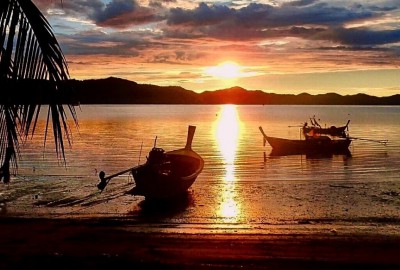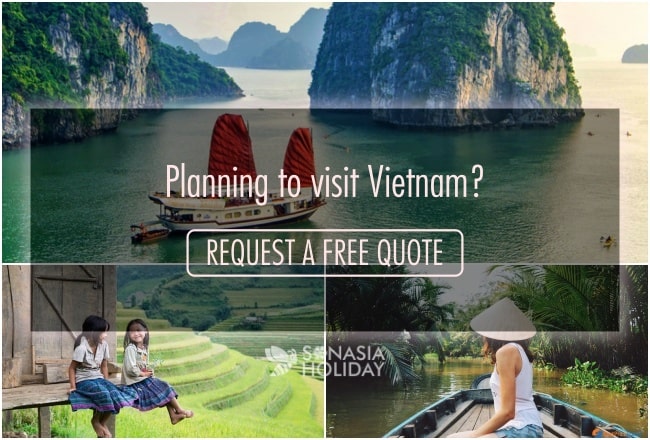Visit Vietnam in about 3 Weeks
Vietnam’s a country with in-depth history, fascinating culture, beautiful beaches, enormous caves, delicious food, fabulous hiking, a buzzing city life, amazing people & landscape full of natural beauty. We are here to help you with checking out how to get the most of it within 3-week plan.

guaranteed! REQUEST A FREE QUOTE
We believe you have the right to arm yourselves with as much information as possible before making any decision.
Check below our detailed tips & guide for every places to visit in Vietnam, recommendation regarding the inclusion in each theme you prefer, and what you can do based on the time frame you have.

As you slink from old-world Hanoi through ancient Hue, past historic Hoi An and to beachy Phan Rang and bustling Ho Chi Minh City, you'll quickly realise that the Vietnamese know a thing or two about delicious food. Pho, banh mi, rice paper rolls – oh my! You’ll be bowled over with the number of offerings on this Essential Vietnam route, from north to south. Not only will you be eating, you’ll be cruising, riding, relaxing, exploring and enjoying all of the Vietnamese hospitality. It sure is a damn tasty slice of this Southeast Asian nation, so there’s only one thing to say: Viet-nom.
Hanoi
Vietnam's capital races to make up for time lost to the ravages of war and a government that as recently as the 1990s kept the outside world at bay. Its streets surge with scooters vying for right of way amid the din of constantly blaring horns, and all around layers of history reveal periods of French and Chinese occupation – offering a glimpse into the resilience of ambitious, proud Hanoians.
Negotiate a passage past the ubiquitous knock-off merchants and you’ll find the original streets of the Old Quarter. Defiant real-deal farmers hawk their wares, while city folk breakfast on noodles, practise t’ai chi at dawn or play chess with goateed grandfathers.
Dine on the wild and wonderful at every corner, sample market wares, uncover an evolving arts scene, then sleep soundly in luxury for very little cost. Meet the people, delve into the past and witness the awakening of a Hanoi on the move.
Ha Long
Towering limestone pillars and tiny islets topped by forest rise from the emerald waters of the Gulf of Tonkin. Designated a World Heritage Site in 1994, Halong Bay's scatter of islands, dotted with wind- and wave-eroded grottoes, is a vision of ethereal beauty and, unsurprisingly, northern Vietnam's number one-tourism hub.
Sprawling Halong City (also known as Bai Chay) is the bay's main gateway, but its high-rises are a disappointing doorstep to this site. Most visitors opt for cruise tours that include sleeping on board within the bay, while a growing number are deciding to eschew the main bay completely, heading straight for Cat Ba Island from where trips to less-visited but equally alluring Lan Ha Bay are easily set up.
Hoi An
Stubbornly traditional and jam-packed with sights, the small city of Hoi An also exudes a laid back, almost dreamy atmosphere that makes it an essential stop on any tour of the country. This intriguing place, with its narrow streets comprising wooden-fronted shophouses topped with moss-covered tiles, has much to recommend it, not least the fact that a concerted effort has been made to retain the city’s old-world charm: by way of example, it’s the only place in Vietnam that places restrictions on motorbike use, and the only place that forces local businesses, by law, to dangle lanterns from their facades. These come to the fore as evening encroaches, and by nightfall you’ll see them shining out from narrow alleys and the riverbank in their hundreds, the light reflecting in the waters of the Thu Bon River. Also notable are the city’s many cheap tailors, who will whip up made-to-measure clothes in no time, and a culinary scene that ranks among the best in Asia.
Hue
Pronounced ‘hway’, this deeply evocative capital of the Nguyen emperors still resonates with the glories of imperial Vietnam, even though many of its finest buildings were destroyed during the American War.
Hue owes its charm partly to its location on the Perfume River – picturesque on a clear day, atmospheric even in less flattering weather. Today the city blends new and old as sleek modern hotels tower over crumbling 19th-century Citadel walls.
A few touts are a minor hassle, but Hue remains a tranquil, conservative city with just the right concentration of nightlife.
Da Nang
Nowhere in Vietnam is changing as fast as Danang. For decades it had a reputation as a provincial backwater, but big changes are ongoing. Stroll along the Han riverfront and you'll find gleaming new modernist hotels, and apartments and restaurants are emerging. Spectacular bridges now span the river, and in the north of the city, the landmark new D-City is rising from the flatlands. Venture south and the entire Danang Beach strip is booming with hotel and resort developments.
That said, the city itself still has few conventional sightseeing spots, except for a very decent museum and a stunningly quirky bridge (or three). So for most travellers, a few days enjoying the city’s beaches, restaurants and nightlife is probably enough. Book an after-dark tour to see Danang at its shimmering neon-lit best. The city's street-food scene also deserves close investigation.
Ho Chi Minh
Ho Chi Minh City (HCMC) is Vietnam at its most dizzying: a high-octane city of commerce and culture that has driven the country forward with its pulsating energy. A chaotic whirl, the city breathes life and vitality into all who settle here, and visitors cannot help but be hauled along for the ride.
From the finest of hotels to the cheapest of guesthouses, the classiest of restaurants to the tastiest of street stalls, the choicest of boutiques to the scrum of the markets, HCMC is a city of energy and discovery.
Wander through timeless alleys to incense-infused temples before negotiating chic designer malls beneath sleek 21st-century skyscrapers. The ghosts of the past live on in buildings that one generation ago witnessed a city in turmoil, but now the real beauty of the former Saigon’s urban collage is the seamless blending of these two worlds into one exciting mass.
Mekong River Delta
The ‘rice bowl’ of Vietnam, the delta is carpeted in a dizzying variety of greens. It's a water world that moves to the rhythms of the mighty Mekong, where boats, houses and markets float upon the innumerable rivers, canals and streams that criss-cross the landscape like arteries.
The bustling commerce of its towns contrasts sharply with the languid, almost-soporific pace of life in the countryside. Here buffalo wallow in rice paddies, coconut- and fruit-laden boats float slowly along the mud-brown waters, and two-wheeled exploration of the narrow lanes is amply rewarded with a true taste of rural hospitality (and delicious river fish).
Elsewhere, mangrove forests teem with a wealth of bird life and bristle with the remains of Viet Cong bunkers, ornate Khmer pagodas and Buddhist temples reaching for the sky, while off-coast islands offer white-sand beaches and tropical hideaways to some, and pirate havens to others.
This route is the combination of some must-see spots such as Hanoi, Ha Long, Hue, Hoi An, Ho Chi Minh city, or Mekong River Delta with some days leisurely enjoying the yellow sandy beaches of central and southern Vietnam coast
Hanoi
Vietnam's capital races to make up for time lost to the ravages of war and a government that as recently as the 1990s kept the outside world at bay. Its streets surge with scooters vying for right of way amid the din of constantly blaring horns, and all around layers of history reveal periods of French and Chinese occupation – offering a glimpse into the resilience of ambitious, proud Hanoians.
Negotiate a passage past the ubiquitous knock-off merchants and you’ll find the original streets of the Old Quarter. Defiant real-deal farmers hawk their wares, while city folk breakfast on noodles, practise t’ai chi at dawn or play chess with goateed grandfathers.
Dine on the wild and wonderful at every corner, sample market wares, uncover an evolving arts scene, then sleep soundly in luxury for very little cost. Meet the people, delve into the past and witness the awakening of a Hanoi on the move.
Ha Long Bay
Towering limestone pillars and tiny islets topped by forest rise from the emerald waters of the Gulf of Tonkin. Designated a World Heritage Site in 1994, Halong Bay's scatter of islands, dotted with wind- and wave-eroded grottoes, is a vision of ethereal beauty and, unsurprisingly, northern Vietnam's number one-tourism hub.
Sprawling Halong City (also known as Bai Chay) is the bay's main gateway, but its high-rises are a disappointing doorstep to this site. Most visitors opt for cruise tours that include sleeping on board within the bay, while a growing number are deciding to eschew the main bay completely, heading straight for Cat Ba Island from where trips to less-visited but equally alluring Lan Ha Bay are easily set up.
Hoi An
Stubbornly traditional and jam-packed with sights, the small city of Hoi An also exudes a laid back, almost dreamy atmosphere that makes it an essential stop on any tour of the country. This intriguing place, with its narrow streets comprising wooden-fronted shophouses topped with moss-covered tiles, has much to recommend it, not least the fact that a concerted effort has been made to retain the city’s old-world charm: by way of example, it’s the only place in Vietnam that places restrictions on motorbike use, and the only place that forces local businesses, by law, to dangle lanterns from their facades. These come to the fore as evening encroaches, and by nightfall you’ll see them shining out from narrow alleys and the riverbank in their hundreds, the light reflecting in the waters of the Thu Bon River. Also notable are the city’s many cheap tailors, who will whip up made-to-measure clothes in no time, and a culinary scene that ranks among the best in Asia.
Hue
Pronounced ‘hway’, this deeply evocative capital of the Nguyen emperors still resonates with the glories of imperial Vietnam, even though many of its finest buildings were destroyed during the American War.
Hue owes its charm partly to its location on the Perfume River – picturesque on a clear day, atmospheric even in less flattering weather. Today the city blends new and old as sleek modern hotels tower over crumbling 19th-century Citadel walls.
A few touts are a minor hassle, but Hue remains a tranquil, conservative city with just the right concentration of nightlife.
Da Nang
Nowhere in Vietnam is changing as fast as Danang. For decades it had a reputation as a provincial backwater, but big changes are ongoing. Stroll along the Han riverfront and you'll find gleaming new modernist hotels, and apartments and restaurants are emerging. Spectacular bridges now span the river, and in the north of the city, the landmark new D-City is rising from the flatlands. Venture south and the entire Danang Beach strip is booming with hotel and resort developments.
That said, the city itself still has few conventional sightseeing spots, except for a very decent museum and a stunningly quirky bridge (or three). So for most travellers, a few days enjoying the city’s beaches, restaurants and nightlife is probably enough. Book an after-dark tour to see Danang at its shimmering neon-lit best. The city's street-food scene also deserves close investigation.
Ho Chi Minh
Ho Chi Minh City (HCMC) is Vietnam at its most dizzying: a high-octane city of commerce and culture that has driven the country forward with its pulsating energy. A chaotic whirl, the city breathes life and vitality into all who settle here, and visitors cannot help but be hauled along for the ride.
From the finest of hotels to the cheapest of guesthouses, the classiest of restaurants to the tastiest of street stalls, the choicest of boutiques to the scrum of the markets, HCMC is a city of energy and discovery.
Wander through timeless alleys to incense-infused temples before negotiating chic designer malls beneath sleek 21st-century skyscrapers. The ghosts of the past live on in buildings that one generation ago witnessed a city in turmoil, but now the real beauty of the former Saigon’s urban collage is the seamless blending of these two worlds into one exciting mass.
Mekong River Delta
The ‘rice bowl’ of Vietnam, the delta is carpeted in a dizzying variety of greens. It's a water world that moves to the rhythms of the mighty Mekong, where boats, houses and markets float upon the innumerable rivers, canals and streams that criss-cross the landscape like arteries.
The bustling commerce of its towns contrasts sharply with the languid, almost-soporific pace of life in the countryside. Here buffalo wallow in rice paddies, coconut- and fruit-laden boats float slowly along the mud-brown waters, and two-wheeled exploration of the narrow lanes is amply rewarded with a true taste of rural hospitality (and delicious river fish).
Elsewhere, mangrove forests teem with a wealth of bird life and bristle with the remains of Viet Cong bunkers, ornate Khmer pagodas and Buddhist temples reaching for the sky, while off-coast islands offer white-sand beaches and tropical hideaways to some, and pirate havens to others.
Nha Trang
Big enough to bustle, yet small enough to retain its relaxed air, the delightful city of Nha Trang has, despite increasingly stiff competition, earned its place as Vietnam’s top beach destination. A grand 6km scythe of soft yellow sand is lapped by rolling waves on one side and fringed on the other by cafés, restaurants, hotels and some unusual modern sculptures. Hawkers are on hand to supply paperbacks, fresh pineapple and massages, while scuba-diving classes and all kinds of watersports are available. Local companies also offer popular day-trips to Nha Trang’s outlying islands, combining hiking, snorkelling and an onboard feast of seafood. Bear in mind that the rainy season, around November and December, sees the sea get choppy and the beach loses much of its appeal.
Vinh Hy Bay
Vinh Hy is a gorgeous natural harbour between Phan Rang and Nha Trang. Accessed via the spectacular Nui Chua Coast Road, the bay is a perfect crescent of blue water hemmed in by rocky cliffs covered in forest. A fishing fleet of blue wooden boats occupies the bay, around which clusters the tiny village of Vinh Hy.
Phan Rang
Sitting bang in between Vietnam’s long-established kitesurfing mecca- Mui Ne– and the raucous city streets of Nha Trang, Phan Rang, Ninh Thuận Province, is the new up-and-coming spot that’s captured the attention of adventure travellers around the globe.
Ninh Van Bay
Welcome to an alternative reality populated by European royalty, film stars and the otherwise rich and secretive. For the average punter not able to afford an uber-luxurious hotel, this place doesn’t exist. Well, at least not before 2017, when the mother-of-all flashpacker retreats opened here on a private bay.
Ninh Van Bay is all about get-away-from-it-all beach bliss, and there's a sprinkling of exquisite sandy coves you can reach by kayak, SUP or boat. There's no road access to the region.
Mui Ne
Once Mui Ne was an isolated strip of coastline with a small traditional fishing village, where only the adventurous travelers camped on the beach. The original fishing village is still there, but nowadays there are more tourists than locals. It has now become a tourist beach destination with a number of luxury hotels, a few cheap hostels, but above all a midrange hotels. The sights on Mui Ne and Phan Thiet range from beautiful beaches, tropical forests and sand dunes to traditional villages, fishing port and ancient Cham buildings and ruins.
Phu Quoc Island
Fringed with white-sand beaches and with large tracts still cloaked in dense tropical jungle, Phu Quoc rapidly morphed from a sleepy island backwater to a must-visit beach escape for Western expats and sun-seeking tourists. Beyond the resorts lining Long Beach, rapid development beginning on the east coast and mega resorts in sight of Sao Beach, there's still ample room for exploration and escaping the sometimes littered waters. Dive the reefs, kayak in the bays, eat up the back-road kilometres on a motorbike or just lounge on the beach, followed by a massage and a fresh seafood dinner.
Phu Quoc is not really part of the Mekong Delta and its rice production; the most famous, and valuable, crop is black pepper. Yet the islanders here have traditionally earned their living from the sea, and its claim to fame across Vietnam is the production of high-quality fish sauce (nuoc mam).
Con Dao Island
Isolated from the mainland, the Con Dao islands are one of Vietnam's star attractions. Long the preserve of political prisoners and undesirables, they now turn heads thanks to their striking natural beauty. Con Son, the largest of this chain of 15 islands and islets, is ringed with lovely beaches, coral reefs and scenic bays, and remains partially covered in tropical forests. In addition to hiking, diving and exploring deserted coastal roads there are excellent wildlife-watching opportunities, such as the black giant squirrel and endemic bow-fingered gecko.
Although it seems an island paradise, Con Son was once hell on earth for the thousands of prisoners who languished in a dozen jails during French rule and the American-backed regime. Many Vietnamese visitors are former soldiers who were imprisoned on the island.
Until recently, few foreigners visited Con Dao, but with the commencement of low-cost boat connections this looks sure to change.
Northern Vietnam is an extremely diverse region in terms of landscapes, ethnic minorities, must-see places and activities available on site. In addition, it is in the north of the country that the capital Hanoi and its various facets are located.
Northern Vietnam also hosts a large number of cultural and historical sites. This is explained in particular by the important place of the North in the history of Vietnam, which we will see here.
Sapa
Sapa is oriented to make the most of the spectacular views emerging on clear days; it overlooks a plunging valley, with mountains towering above on all sides. Views are often subdued by thick mist rolling across the peaks, but even when it's cloudy, local hill-tribe people fill the town with colour.
Mai Chau
Three hours out from the Vietnamese capital of Hanoi, as you cross into the mountainous Hoa Binh province to the west, the landscape transforms from congested rowhouses to wide-open ricefields, karst mountains, and quaint wood-and-bamboo villages. Welcome to Mai Chau, a rural valley whose towering cliffs, unique culture and laid-back atmosphere attract visitors keen to experience the land and lifestyle of Vietnam's northwest. Spend a couple of days here, and you'll forget what century you're in. Spend the daylight hours exploring the local Tai Dam and Tai Kao villages and biking around the brilliant-green rice fields, then fill your evenings drinking the local beer and enjoying traditional Tai dances. Check off the activities listed below, and you can boast you've made the most of your Mai Chau getaway!
Pu Luong
One glance at the Pu Luong Nature Reserve and you’ll see why the ethnic Thai people made this enchanting valley their home long ago. The slow pace in Pu Luong is a striking contrast to life in the capital just a few hours away. Endless mountains, fertile valleys and pristine jungle are just a few good reasons to visit. Here are seven ways to make the most of your time in this beautiful destination.
Dien Bien Phu
Dien Bien Phu (DBP) plays a star role in Vietnam's modern history. It was in the surrounding countryside here, on 7 May 1954, that the French colonial forces were defeated by the Viet Minh in a decisive battle, and the days of their Indochina empire became numbered.
Son La
The region is one of Vietnam’s most ethnically diverse and home to more than 30 different minorities, including Black Thai, Meo, Muong and White Thai. Vietnamese influence was minimal until the 20th century, and from 1959 to 1980 the area was part of the Tay Bac Autonomous Region.
Lai Chau
Lai Chau is a province located 450 kilometres from Hanoi in northern Vietnam, and is particularly known for its mountains and ethnic minorities. The landscape is beautiful and made up of high mountain ranges stretching from the northwest to the southeast with narrow valleys, beautiful rivers and springs completing the natural beauty of the place.
Bac Son Valley
Bac Son is a rural district of Lang Son Province from the Northeast region of Vietnam. It's located 160 km northeast of Hanoi. Among the intriguing aspects about it valley is its own incredibly high mountains that are about 500 - 1200 meters high. These mountains, along with the valley's paddy fields, create a great scenic landscape that you could just see best after climbing on the top of a mountain. That is located only a couple of minutes from the town. The valley's pathways lead you to the paddy areas, where you will get a possibility to see the beautiful river crossing the rice areas.
Cao Bang
While talking to Cao Bang province all people will think it's famous with Ban Gioc waterfall. But not only with Ban Gioc but Cao Bang province also famous for it's history. Because the Uncle Ho. The first president of Vietnam returned on December 1941 through China. Being located directly on the boundary with China supposed that Cao Bang was a zone of contention between the two countries. It also played a significant part in the movement, acting as a basis for the North Vietnamese revolutionaries and earning the nickname Cradle of the Revolutionary Movement.
Ha Giang
A border province and official Frontier Area, Hà Giang lies in the remote far northern region of the country. To visit this province is to journey back in time and encounter some of Vietnam’s most rugged and grand landscapes. Hà Giang is best experienced as a road trip on two wheels, soaking up the majesty of the landscape and the atmosphere of the remote towns and minority villages.
Ba Be Lake
The lake was formed over 200 million years ago. The lake built up on the limestone mountains, creating the lake. The greatest value of Ba Be Lake is its unique geological landscape, outstanding geomorphological value and tremendous biodiversity value. This is the largest natural fresh water lake in Vietnam.
In 1995, Ba Be Lake was recognized by the World Hook Conference. Ba Be lake as one of 20 special freshwater lakes of the world that need protection. At the end of 2004, Ba Be National Park was recognized as the ASEAN Heritage Garden.
With its endless mountains and forests, green hills and sweeping rice paddies, northeastern Vietnam is a place unlike any other. The region’s natural beauty is absolutely breathtaking and will make a trip here one of your top experiences while in the country. To get a real feel for this area and have a chance to see some of its more remote and all the more spectacular sights, we recommend you spend at least 2 week here.
Bac Son Valley
Bac Son is a rural district of Lang Son Province from the Northeast region of Vietnam. It's located 160 km northeast of Hanoi. Among the intriguing aspects about it valley is its own incredibly high mountains that are about 500 - 1200 meters high. These mountains, along with the valley's paddy fields, create a great scenic landscape that you could just see best after climbing on the top of a mountain. That is located only a couple of minutes from the town. The valley's pathways lead you to the paddy areas, where you will get a possibility to see the beautiful river crossing the rice areas.
Cao Bang
While talking to Cao Bang province all people will think it's famous with Ban Gioc waterfall. But not only with Ban Gioc but Cao Bang province also famous for it's history. Because the Uncle Ho. The first president of Vietnam returned on December 1941 through China. Being located directly on the boundary with China supposed that Cao Bang was a zone of contention between the two countries. It also played a significant part in the movement, acting as a basis for the North Vietnamese revolutionaries and earning the nickname Cradle of the Revolutionary Movement.
Ha Giang
A border province and official Frontier Area, Hà Giang lies in the remote far northern region of the country. To visit this province is to journey back in time and encounter some of Vietnam’s most rugged and grand landscapes. Hà Giang is best experienced as a road trip on two wheels, soaking up the majesty of the landscape and the atmosphere of the remote towns and minority villages.
Ba Be Lake
The lake was formed over 200 million years ago. The lake built up on the limestone mountains, creating the lake. The greatest value of Ba Be Lake is its unique geological landscape, outstanding geomorphological value and tremendous biodiversity value. This is the largest natural freshwater lake in Vietnam.
In 1995, Ba Be Lake was recognized by the World Hook Conference. Ba Be lake as one of 20 special freshwater lakes of the world that need protection. At the end of 2004, Ba Be National Park was recognized as the ASEAN Heritage Garden.
This wild, remote region contains some of Vietnam’s most awe-inspiring scenery, sparsely populated by a fascinating mosaic of ethnic minorities. Most visitors gravitate to the northwest, where the country’s highest mountain range and its tallest peak, Mount Fan Si Pan, rise abruptly from the Red River Valley. Within its shadow lies Sa Pa, a former French hill station and the base for trekking through superb scenery to isolated minority hamlets.
To the east of the Red River, Bac Ha’s major draw are the Flower Hmong, whose markets are great fun. These two towns – and the historic battlefield of Dien Bien Phu, the site of the Viet Minh’s decisive victory over French forces in 1954 – are the most visited places in the north. From Dien Bien Phu, it’s worth considering the scenic route back to Hanoi, passing though Son La, with its forbidding penitentiary, and Mai Chau, with its gorgeous scenery.
Sapa
Sapa is oriented to make the most of the spectacular views emerging on clear days; it overlooks a plunging valley, with mountains towering above on all sides. Views are often subdued by thick mist rolling across the peaks, but even when it's cloudy, local hill-tribe people fill the town with colour.
Mai Chau
Three hours out from the Vietnamese capital of Hanoi, as you cross into the mountainous Hoa Binh province to the west, the landscape transforms from congested rowhouses to wide-open ricefields, karst mountains, and quaint wood-and-bamboo villages. Welcome to Mai Chau, a rural valley whose towering cliffs, unique culture and laid-back atmosphere attract visitors keen to experience the land and lifestyle of Vietnam's northwest. Spend a couple of days here, and you'll forget what century you're in. Spend the daylight hours exploring the local Tai Dam and Tai Kao villages and biking around the brilliant-green rice fields, then fill your evenings drinking the local beer and enjoying traditional Tai dances. Check off the activities listed below, and you can boast you've made the most of your Mai Chau getaway!
Pu Luong
One glance at the Pu Luong Nature Reserve and you’ll see why the ethnic Thai people made this enchanting valley their home long ago. The slow pace in Pu Luong is a striking contrast to life in the capital just a few hours away. Endless mountains, fertile valleys and pristine jungle are just a few good reasons to visit. Here are seven ways to make the most of your time in this beautiful destination.
Dien Bien Phu
Dien Bien Phu (DBP) plays a star role in Vietnam's modern history. It was in the surrounding countryside here, on 7 May 1954, that the French colonial forces were defeated by the Viet Minh in a decisive battle, and the days of their Indochina empire became numbered.
Son La
The region is one of Vietnam’s most ethnically diverse and home to more than 30 different minorities, including Black Thai, Meo, Muong and White Thai. Vietnamese influence was minimal until the 20th century, and from 1959 to 1980 the area was part of the Tay Bac Autonomous Region.
Lai Chau
Lai Chau is a province located 450 kilometres from Hanoi in northern Vietnam, and is particularly known for its mountains and ethnic minorities. The landscape is beautiful and made up of high mountain ranges stretching from the northwest to the southeast with narrow valleys, beautiful rivers and springs completing the natural beauty of the place.
And much much more awaiting for your exploration



















